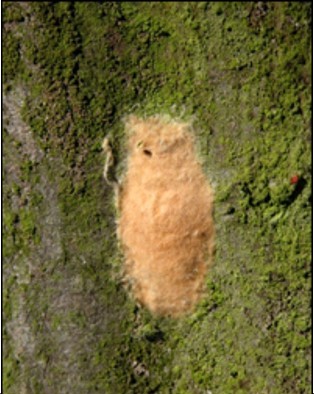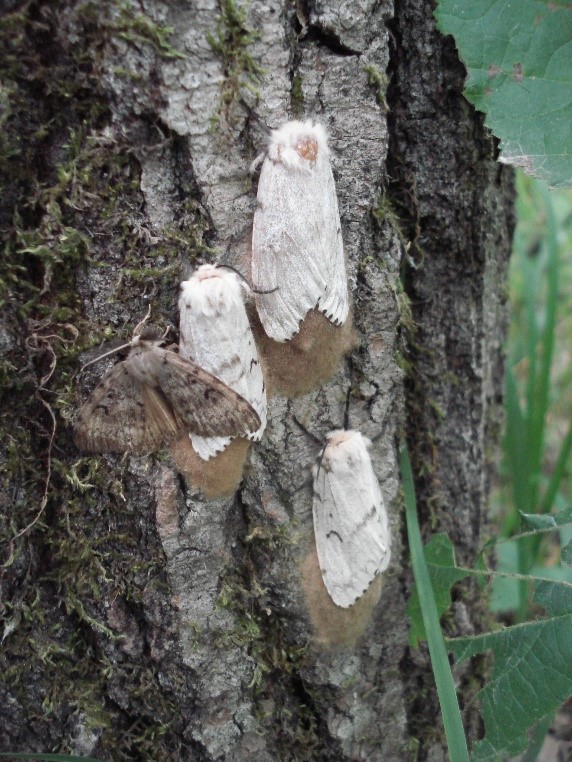Spongy moth (Lymantria dispar) looks very different in each of its life stages:
Egg masses
 Egg masses are usually ovals, about 1 inch by 1 1/2 inches, although they may be more irregularly shaped. They are tan and often are hidden in protected spots, such as under patio furniture and in wood piles. At higher populations, egg masses may be clearly visible on tree branches. Egg masses may contain up to 1000 eggs and can be found August-May. (Photo: Spongy moth egg mass, forestryimages.org)
Egg masses are usually ovals, about 1 inch by 1 1/2 inches, although they may be more irregularly shaped. They are tan and often are hidden in protected spots, such as under patio furniture and in wood piles. At higher populations, egg masses may be clearly visible on tree branches. Egg masses may contain up to 1000 eggs and can be found August-May. (Photo: Spongy moth egg mass, forestryimages.org)
Caterpillars
 Caterpillars, or larvae, are the destructive part of spongy moth's life cycle. Caterpillars emerge in early May to early June. They feed for the next several weeks, growing to about 2 inches long. The red and blue dots on their backs distinguish them from native species of caterpillars that may be feeding at the same time. (Photo: Spongy moth caterpillar, forestryimages.org)
Caterpillars, or larvae, are the destructive part of spongy moth's life cycle. Caterpillars emerge in early May to early June. They feed for the next several weeks, growing to about 2 inches long. The red and blue dots on their backs distinguish them from native species of caterpillars that may be feeding at the same time. (Photo: Spongy moth caterpillar, forestryimages.org)
Pupae
Caterpillars feed for 4-6 weeks and then pupate, forming a brown shell that protects them while they develop into adult moths. Pupae are usually in very protected spots and may be hard to find. (Photo: forestryimages.org)
Adults
 Adult male and female
spongy moth look very different. The females are larger, white and cannot fly. Adults are smaller, brown and fairly drab, but with very large, feathery antennae. They fly very rapidly and erratically, looking for females. Adults do not feed. They die after mating and, for females, after they lay several egg masses. They are active in late July to mid-August. (Photo: forestryimages.org)
Adult male and female
spongy moth look very different. The females are larger, white and cannot fly. Adults are smaller, brown and fairly drab, but with very large, feathery antennae. They fly very rapidly and erratically, looking for females. Adults do not feed. They die after mating and, for females, after they lay several egg masses. They are active in late July to mid-August. (Photo: forestryimages.org)
You can find many more photos of spongy moth and the damage they cause at forestryimages.org.
Back to spongy moth page